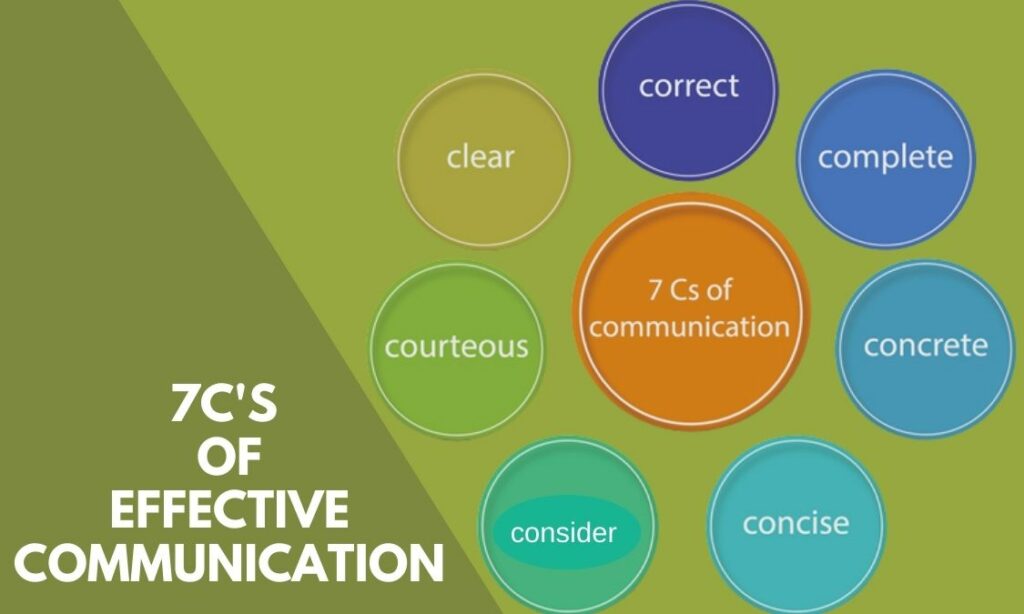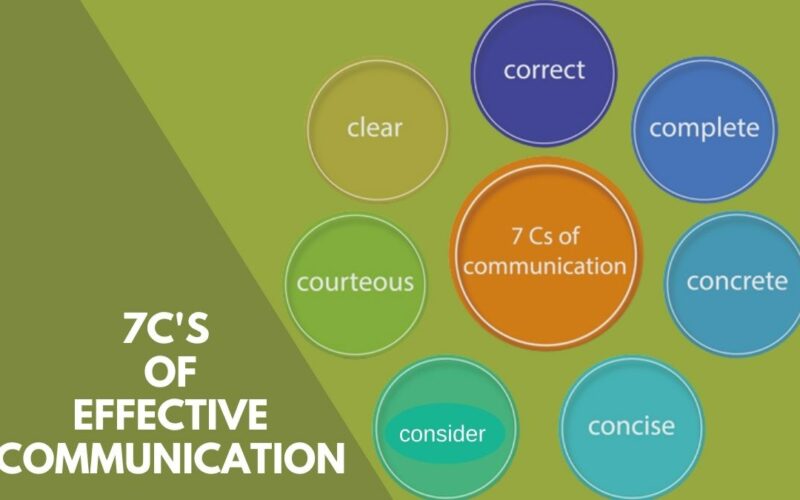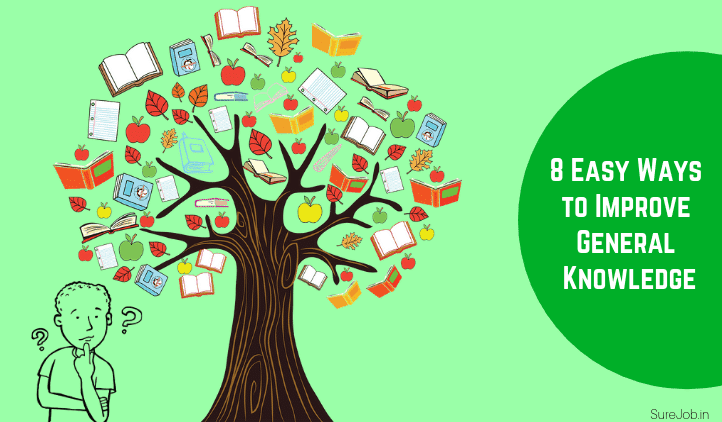Communication is the exchange of ideas, thoughts, words, expressions, gestures, and other things.
The Latin word “communism,” which means “common,” is where the word “communication” comes from a historical point of view, communication is when people interact with each other or with their own thoughts and come to a permanent or temporary point of agreement or view.
The Oxford Concise Dictionary says that communication is the sharing of information. Communication is very important in every aspect of life, whether it's between countries, in political speeches by leaders, in business organizations, in university classes, etc. So, it has to work well if you want to save time and effort and get the results you want.
In their book “Effective Public Relations” from 1952, Scott M. Cutlip and Allen H. Centre came up with the idea of the Seven C's (7Cs) of effective communication. This was the first book of its kind on the subject of public relations.
The 7c's of effective communication means the brief and polite way of communicating with the people around you. The 7 c's are clear, correct, complete, concrete, concise, considered, and courtesy.
The 7Cs of communication are actually a set of rules for how to talk to everyone in a way that helps them understand what you want to say. People can use these principles as guidelines to learn how to influence other people for their own or their organization's goals.
These are completeness, brevity, consideration, concreteness, clarity, courtesy, and correctness. Here are the details of the 7Cs of communication and why they are important for good communication.

7C's of Effective Communication
1. The 1st C is CLEAR
The first point C is clear, which means when you communicate with someone, you need to be clear with your words so that the person can understand them.
There are different steps to getting clear communication. First, it's needed to be clear about why you're sending the message.
The person who is getting the message should know why they are getting it and what you want to do with it. If there is more than one goal, each one should be set out on its own.
Second, it's important that the message itself is easy to understand. It would be best if you stayed away from jargon and use simple words and sentences you are going through, which make it clear to understand what you want to say.
Clarity is important for good communication because it takes away the fog of assumptions from the other person's mind.
Pope John Paul-ll said, “Know what you're talking about,” which is a well-known phrase that means you should know what you're talking about.
2. The 2nd C is CORRECT
The second point, C is correct, which means It's very important that everything whatever you say should be correct.
If the person you are addressing notices a mistake in what you say, it takes their attention away from you and hurts your credibility a lot. It will make it difficult for you to get your message across.
The set of information used during communication needs to be reliable and back up the information given during communication.
For example, if a company wants to market its products well, its representatives need to be able to talk to different markets or people in the right way.
3. The 3rd C is COMPLETE
The third point, C is complete, which means that the person should complete his words properly so that the person is addressing can understand it in a better way and realize what the person what to say it makes the communication easy and smooth.
For example, it's important for a teacher to know how the students in a class think and give them information that fits their needs.
The teacher and the students will be able to talk to each other well if the teacher answers the questions that the students bring up.
Also, you should make things as easy as possible for the person who is getting the message. For example, if you're making a “call to action,” tell people exactly what they should do.
In written communications, it's becoming more common to include things like hyperlinks or a list of frequently asked questions.
Both of these things help people get a piece of full information about which he wants to express and what he needs to say to make things easier.
4. The 4th C is CONCRETE
The fourth point, C is Concrete. When planning your communication, you should be at ease that the idea and words you are using to express what you want to say should match each other communication.
It may be important to show your audience how solid “what you've made” is by giving them examples that show how your messages are important to them as individuals.
Compared to general talks, this has a big effect on the people who hear them. For example, focusing on how a car performs in terms of speed, gas mileage, and looks will be more effective than comparing it to other brands of the same type in a general way.
5. The 5th C is CONCISE
The fifth point, C is Concise. When sending these kinds of messages, it's important for you to know that if fewer words can be expressed, you should be expressive with short sentences that can describe the whole thing in spite of speaking a lot of words.
The more you speak to people, the chances are likely it is that you will confuse people. You can avoid this risk by focusing only on the most important things you need to say.
It works better when the people receiving it, care more about time than communication. So, giving clear, useful information in a short amount of time would be seen as an effective way to communicate, and the audience would also respond positively.
6. The 6th C is CONSIDERED
The sixth point C is considered. If your messages don't make sense, they won't get through.
To make sure your communications are well-thought-out and make sense, they should follow the rule that you should be confident, clear, and sensible when you share your views with another person, and it should make sense on its own; you should also make sure that the messages you send are all the same.
The communication is mostly positive and focuses on the needs, thoughts, and requirements of the people receiving it.
For example, when political leaders talk to the public, they mostly talk about the needs and sufferings of the people, which have a direct effect on the people they are talking to and make them feel something. This can actually turn an ordinary conversation into a good one.
7. The 7th C is COURTESY
The seventh point, C is courtesy. You can make your communications more effective by being gentle and depicting that you worry about the people you are addressing.
The words you express should be nice, thoughtful, kind, fruitful, and true. To be polite, you should always try to understand your audience and think about your messages from their point of view.
Also read: Ways to Improve Communication Skills
Importance of 7C's of Effective Communication
The seven C's of communication can be used as a checklist when you want to send a message or give a group of facts.
They are, however, less useful for communications that are more emotional, persuasive, and based on rhetoric.
Their focus on detail, brevity, and clarity help make sure your audience gets the main points of what you want to say, but they don't tell you much about how to make your audience feel something.
The 7 Cs of effective communication can help with written and spoken communication in a lot of situations. We think they work best for emails that are meant to keep people informed or for one-on-one conversations that are mostly about doing business.
The 7C's of communication help to persuade people, lead them through change, or win their hearts and minds; you should use a different way of communicating, such as the 5 Canons of Rhetoric, Storytelling, or Monroe's Motivated Sequence.
When we work with clients or give seminars on communication, we often talk about how important it is to connect with, understand, and be understood by other people. For teams to do well, they need to communicate in this way.
Still, it can make sure that everyone is on the same page when communicating. For example, even though people from different ethnic groups have different cultures, they can still communicate well if they don't say bad things about each other.
Conclusion
So, effective communication plays an important role in several aspects, which is Organizations, businesses, and public relations all want to be able to communicate well.
The 7Cs of effective communication can help build a better society by educating people and interacting with them in an order that helps them understand your point of view and respond to it.
Famous politicians do talk to the public in a way that is clear, convincing and makes no mistakes. “If you talk to a person in a language he understands, that goes to his head,” Nelson Mandela once said. If you speak his language, you'll get to his heart.”








